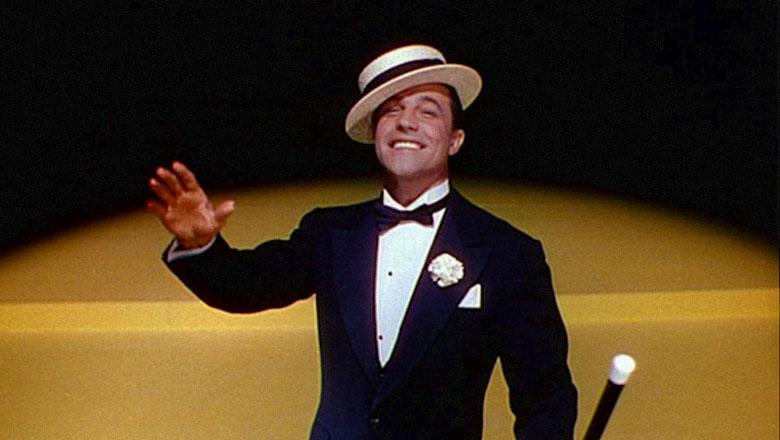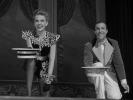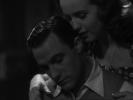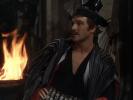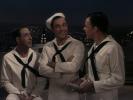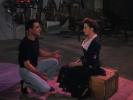Credits
Feature by: Cullen Gallagher, Victoria Large, and Veronika Ferdman
Posted on: 19 August 2012
There’s something appealingly improbable about Gene Kelly’s career as a leading man. It’s not that he wasn’t an extraordinarily gifted performer, or that he was anything less than movie star handsome. But he is an idiosyncratic figure, distinct from the other male stars of his era. As other critics have noted, Kelly’s energetic turns in upbeat musical fare are nearly always complicated by a certain brashness, a willingness to be disliked that keeps him from taking on what Pauline Kael called the “candied-yam cheerfulness” of performers like Dick Powell. He even got his start playing heels: he was the famously unsympathetic lead in Broadway’s Pal Joey, and in his screen debut in For Me and My Gal, he played a draft dodger who made poor Judy Garland cry. Prior to Kelly’s breakthrough roles in 1944’s Cover Girl and 1945’s Anchors Aweigh, MGM Studios actually seemed unsure of what to do with him. When not loaning him out to other studios, they were casting him in their own nonmusical thrillers (The Cross of Lorraine, Pilot #5) or in overstuffed song-and-dance extravaganzas like Thousands Cheer and Du Barry was a Lady – films that hedged their bets by throwing in everything but the kitchen sink, leaving Kelly little room to distinguish himself. Kelly confused MGM because he didn’t quite fit into a preexisting type – but that uniqueness is also what ultimately made him a star.
It’s routinely noted that as a dancer, Kelly offers something different than the tuxedoed, airy Fred Astaire, but that difference is often oversimplified. It isn’t just that Kelly possesses the working class edge of a performer who was more comfortable in a baseball cap than a top hat. Astaire is otherworldly – in our collective memory, he is forever gliding across a dreamlike Art Deco set, intoning the word “heaven†– but onscreen Kelly is always earthy and flawed. His characters have the potential to hurt and be hurt, and they frequently mask their insecurities with a bravado that threatens to slip. Yet this humanity and indeed, vulnerability, in many ways places Kelly’s grace and confidence as a dancer in sharper relief. Those perfect little moments in Kelly’s dance routines – think of his effortless leap onto the lamppost in Singin’ in The Rain, or that expertly executed knee-slide during the ballet sequence in On the Town – are transcendent in part because we know that his characters have something to transcend.
Kelly had an unusual level of creative control for a star of his time – he co-directed three of his best films as a leading man, and choreographed many more – and he was a technical innovator too, pushing for the mix of live action and animation that wowed audiences in Anchors Aweigh, for example, or working with complex special effects in Cover Girl. But it may be Kelly’s ability to create magic out of the simplest of ingredients that has done the most to ensure his legacy. His characters often dance their way through lavish Technicolor fantasy sequences – not the least of which is the staggering ballet that concludes An American in Paris – but many of his fans are fondest of the bits that are deceptively simple: dances that employ unlikely props like a mop, a floorboard, or an umbrella.
This year marks Kelly’s centennial – he was born on August 23, 1912 – and many of his best films have endured on video and as rep theatre favorites, while the bite-sized and compulsively watchable nature of his dance numbers make them naturals for online viewing via Youtube. His influence has remained evident onscreen in musicals and elsewhere. To wit: our most recent Best Picture winner, The Artist, echoes the plot of Singin’ in the Rain, and it’s hard not to see something of Gene Kelly in its star Jean Dujardin’s megawatt grin. But perhaps the greatest tribute that one can pay Kelly, beyond even the most glowing recollections of his performances, is to make this simple observation: because of him, many of us react differently to a squeaky floorboard, or to being caught in the rain. Maybe, despite ourselves, we react with a smile. Or maybe we hum. Or sing. Maybe we dance.
Please refer to this page during the next week as we review a variety of films, musical and otherwise, from Kelly’s career as a leading man.
Introduction by Victoria Large
By Cullen Gallagher, Victoria Large, and Veronika Ferdman ©2012 NotComing.com
Reviews
We don’t do comments anymore, but you may contact us here or find us on Twitter or Facebook.



